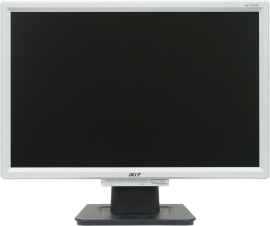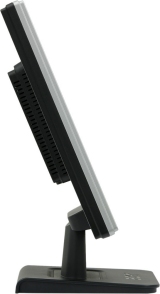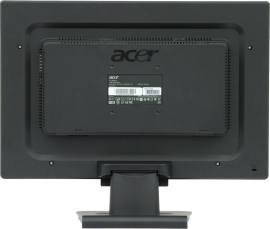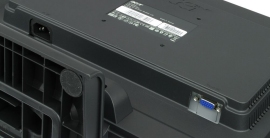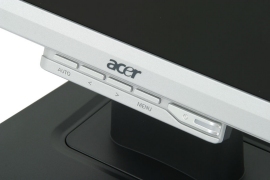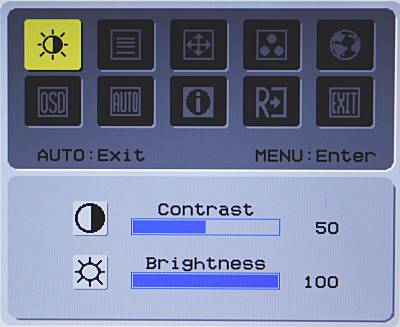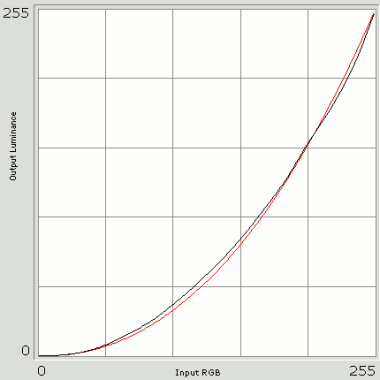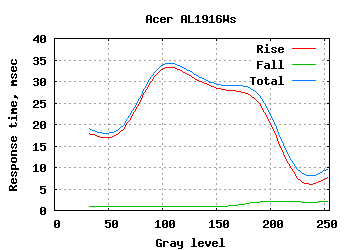LCD MONITOR REVIEW ACER AL19 INCH16WS 19 INCH
![]()
|
|
 |
||||||||||||
| Posted:2006-07-08 By lcd monitor Number of View:86839 |
|||||||||||||
By :lcd monitor Posted:2006-07-08
Acer AL19 inch16WsWidescreen lcd 19 inch monitors with an aspect ratio of 16:10 rather than 5:4 or 4:3 had been largely ignored by the public until recently. The main problem was that such lcd 19 inch monitors were in fact cut-down versions of ordinary matrixes in terms of matrix resolution: the standard 19 inch” monitor has a native resolution of 1280x1024 (or 1.31 megapixels) whereas the typical widescreen lcd 19 inch monitor had a resolution of 1280x768 (0.98 megapixels or two thirds the total area). And while it was all right to use widescreen matrixes in TV-sets for which the physical size is more important than the number of pixels, the reduction of workspace by one third wasn’t at all welcome in PC monitors. Moreover, pixels in widescreen matrixes just looked large (they don’t look small even on ordinary 19 inch” matrixes). Still, it goes without saying that widescreen lcd 19 inch monitors brings about a number of advantages over ordinary ones. It is easier to organize your workspace on them by tucking the additional menus, toolsets, etc. away to the sides of the document (photograph, a fragment of program code) you are working on. Widescreen displays are also superior in terms of ergonomics because it is easier to place them in the right way on the desk (ergonomics demands that the top of the screen be not higher than your eyes level). The eyes are also getting tired less when moving left and right rather than up and down. And now the manufacturers seem to have listened to the customers’ cries and introduced a new type of widescreen 19 inch” matrixes with an increased native resolution of 1440x900 (1.3 megapixels which almost equals the total area of a classic 1280x1024 matrix). Quite a few companies have already produced their lcd 19 inch monitors on such matrixes. Acer in particular released an AL19 inch16Ws model. The 1400x900 matrixes are currently being manufactured with TN+Film technology exclusively, with a curious consequence: the horizontal viewing angle of modern TN+Film matrixes is already quite wide while the vertical one calls for improvement, so the wide TN matrixes look even better in practice than classic TN matrixes with the same diagonal! But surely it would be good if this widescreen trend were spread to S-IPS and MVA/PVA technologies, too. I want to draw your attention to the fact that the aspect ratio of the widescreen matrixes for PC lcd 19 inch monitors is 16:10 rather than 16:9, so there will be narrow black bands above and below the frame when you are watching movies on them.
The monitor is assembled in the uniform case for Acer’s low-end models which doesn’t show any trace of originality in design.
The stand only allows adjusting the tilt of the screen. It’s also rather flimsy, so the monitor wobbles all over at the slightest push.
You can attach a standard VESA mount to the four screw-holes in the back panel. There is no decorative cap over the holes.
The monitor has an analog input only and is equipped with an integrated power adapter. Of course, it’s a drawback not to have a digital input here, but the lcd 19 inch monitor worked normally on the Radeon X600 graphics card our testbed is fitted with, yielding a sharp and noise-free picture and not requiring manual image setup.
The monitor’s controls are located separately on a slat below the case. The Power button differs in shape and size from the others and is highlighted with a mild green LED at work. Quick access is provided to the automatic image adjustment feature. The “<” and “>” buttons have no purpose outside the menu.
The lcd 19 inch monitor has a standard and rather handy menu from Acer. It doesn’t offer any extra features, though, just the basic settings any LCD monitor offers. By default, the contrast and brightness settings are set at 50% and 100%, respectively. By choosing 27% brightness and 30% contrast I achieved 100-nit brightness of white. The lcd 19 inch monitor’s brightness is controlled through pulse-width modulation of the power of the backlight lamps at a frequency of 270Hz. The backlighting is quite uniform, yet on closer examination you can discern that the top and bottom of the screen are darker than the rest of it. Just as I said above, the viewing angles of this lcd 19 inch monitor are quite normal for a modern TN+Film matrix, but the narrowness of the vertical angle isn’t that striking in comparison with an ordinary 19 inch” monitor due to the reduced height of the screen. The difference isn’t big, though, and if you are not satisfied with the vertical viewing angle of a standard 1280x1024 TN matrix, you’d better consider matrixes with other manufacturing technologies rather than with a different screen aspect ratio. The lcd 19 inch monitor produces undesirable bands in color gradients, but they are not very conspicuous. These bands are not affected by the monitor’s settings (it often happens that a monitor is well tuned up at its default settings, but you can see errors in color gradients as soon as you change the contrast setting).
The gamma curves lie very close to the theoretical curves for gamma 2.2. There are no problems here that would affect the reproduction of light or dark tones. The situation doesn’t change at the reduced brightness and contrast – the lcd 19 inch monitor still honestly reproduces all the color tones it is supposed to show.
There is a small difference between the temperatures of levels of gray, which is an achievement for a low-end lcd 19 inch monitor. The problem is that the image looks cold. Even in the Warm mode the temperature doesn’t lower to the sRGB standard 6500K whereas a majority of other lcd 19 inch monitors produce something like 5400K in their Warm modes. So, if you’ve got a rather “warm” illumination at your home, you may want to manually set up the color temperature of your AL19 inch16Ws.
The AL19 inch16Ws’s matrix lacks response time compensation, so its speed cannot impress. The pixel rise time is over 30 milliseconds at the maximum and goes down to acceptable level on black-white transitions only. Well, this is quite a typical picture for RTC-less TN+Film matrixes, but it anyway looks depressing after you’ve seen the latest models of gaming lcd 19 inch monitors.
The AL19 inch16Ws’s brightness and contrast are quite typical for its class – there’s nothing to be surprised at. The max brightness of 250 nits allows playing games and watching movies with comfort even under bright lighting. Thus, the AL19 inch16Ws may be an interesting option for people who’d want to have a widescreen 19 inch” monitor but are not satisfied with the low resolution and large pixels of the older 1280x768 matrixes. The lcd 19 inch monitor suits well for work and for watching movies (a special thanks to the wide display!), but you should think twice if you need a lcd 19 inch monitor for playing games. The matrix installed in the AL19 inch16Ws is way slower than the matrixes of modern gaming lcd 19 inch monitors. Don’t forget about the type of the matrix, too. The characteristic problems of TN+Film technology with viewing angles may have become less annoying, but have not disappeared yet..
we would be happy to answer for your question . if you have suggestion or comment
regarding this review our support would be glad to help just join our forum and ask u will get the best answer
to discuss check our forum section :-) RATE THIS REVIEW | |||||||||||||
![]()

7600gt review
7600gt is the middle card range.
We already benchmarked this video card and found that ...

 geforce 8800gtx and 8800gts
geforce 8800gtx and 8800gts  Xtreview software download Section
Xtreview software download Section  AMD TURION 64 X2 REVIEW
AMD TURION 64 X2 REVIEW  INTEL PENTIUM D 920 , INTEL PENTIUM D 930
INTEL PENTIUM D 920 , INTEL PENTIUM D 930  6800XT REVIEW
6800XT REVIEW  computer hardware REVIEW
computer hardware REVIEW  INTEL CONROE CORE DUO 2 REVIEW VS AMD AM2
INTEL CONROE CORE DUO 2 REVIEW VS AMD AM2  INTEL PENTIUM D 805 INTEL D805
INTEL PENTIUM D 805 INTEL D805  Free desktop wallpaper
Free desktop wallpaper  online fighting game
online fighting game  Xtreview price comparison center
Xtreview price comparison center 

- The new version of GPU-Z finally kills the belief in the miracle of Vega transformation
- The motherboard manufacturer confirms the characteristics of the processors Coffee Lake
- We are looking for copper coolers on NVIDIA Volta computing accelerators
- Unofficially about Intels plans to release 300-series chipset
- The Japanese representation of AMD offered monetary compensation to the first buyers of Ryzen Threadripper
- This year will not be released more than 45 million motherboards
- TSMC denies the presentation of charges from the antimonopoly authorities
- Radeon RX Vega 64 at frequencies 1802-1000 MHz updated the record GPUPI 1B
- AMD itself would like to believe that mobile processors Ryzen have already been released
- AMD Vega 20 will find application in accelerating computations
- Pre-orders for new iPhone start next week
- Radeon RX Vega 57, 58 and 59: the wonders of transformation
- ASML starts commercial delivery of EUV-scanners
- The older Skylake processors with a free multiplier are removed from production
- Meizu will release Android-smartphone based on Helio P40
- AMD Bristol Ridge processors are also available in American retail
- The fate of Toshiba Memory can be solved to the next environment
- duo GeForce GTX 1080 Ti in GPUPI 1B at frequencies of 2480-10320 MHz
- New Kentsfield overclocking record up to 5204 MHz
- Lenovo released Android-smartphone K8



computer news computer parts review Old Forum Downloads New Forum Login Join Articles terms Hardware blog Sitemap Get Freebies

